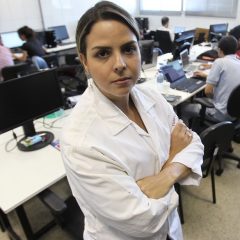
MODELING AND DRUG DESIGN


International Rising Talents






for a Zika cure













Our research group is focused on designing of new drug candidates for infectious diseases such as Chagas disease, schistosomiasis, leishmaniasis, malaria and tuberculosis, as well as for cancer. Another important goal of our group is the development of predictive models for pharmacokinetics and toxicity properties. The work developed by our group has resulted in publications in international indexed journals, abstracts, dissertations and awards in national and international meetings of Medicinal and Computational Chemistry area.
We aim to design and develop new chemical entities for the treatment of neglected tropical diseases, such as Dengue, Malaria, Schistosomiasis, Leishmaniasis, Chagas disease, among others, using structure-based drug design (SBDD) and ligand-based drug design (LBDD) strategies for the identification of selective inhibitors of target enzymes, by the combination of experimental and computational approaches.

Professor and Lab Head

Ph.D. student at UFG

Postdoctoral Research Associate at UNC, USA

Senior Research Scientist at Altox
Optimization of pharmacokinetics properties (ADME: absorption, distribution, metabolism and excretion) at early stages of drug development has become an essential task to enhance the success rate of new drugs. We are working to overcome or reduce ADME late-stage failures by developing in silico tools or platforms to predict and optimize some of those properties, such as metabolism, Caco-2 cell permeability, blood-brain barrier penetration (BBBP), water solubility, among others, aiming to help the selection of compounds for clinical development.

Professor and Lab Head

Ph.D. student at UFG

Postdoctoral Research Associate at UNC, USA

Senior Research Scientist at Altox
We aim to apply computer methods to predict adverse effects of chemicals on human health and the environment, as well as to understand the mechanisms underlying the adverse outcome pathway of toxicological endpoints. The application of high-powered computing techniques allows us to manage and detect patterns and interactions in large biological and chemical data sets that helps to select potentially safer compounds to continue on the drug discovery pipeline.

Professor and Lab Head

Research Assistant Professor at UNC, USA

Postdoctoral Research Associate at UNC, USA

Senior Research Scientist at Altox
The OpenZika project on World Community Grid aims to identify drug candidates to treat the Zika virus in someone who has been infected. The project will target proteins that the Zika virus likely uses to survive and spread in the body based on what is known from diseases such as dengue virus and yellow fever. In order to develop an anti-Zika drug, researchers need to identify which of millions of chemical compounds might be effective at interfering with these key proteins. The effectiveness of each compound will be tested in virtual experiments, called “docking calculations,” performed on World Community Grid volunteers’ computers and Android devices. These calculations will help researchers focus on the most likely compounds that may eventually lead to an antiviral medicine.

Professor at Universidade Federal de Goiás and LabMol Head

Research Associate at LabMol

Research Teaching Specialist at Rutgers University

CEO, Collaborations Pharmaceuticals, Inc.

Senior Research Scientist at Altox

Professor at the Federal University of Goiás
